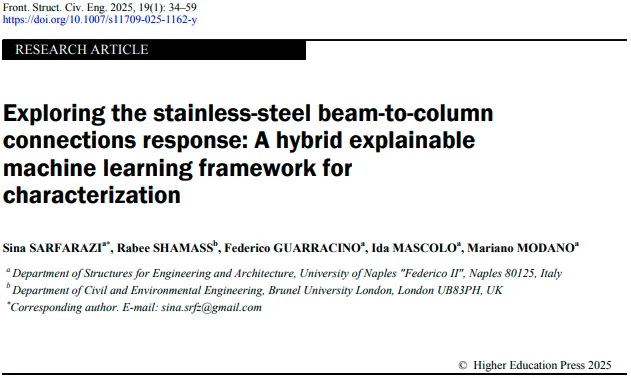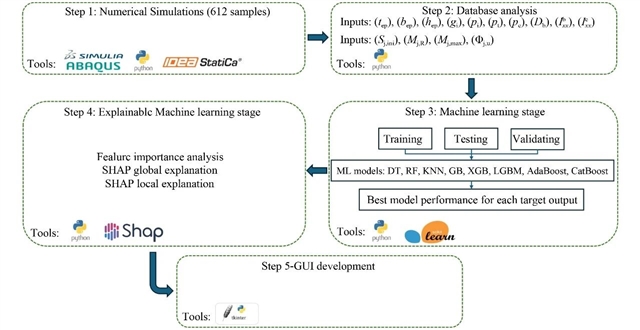|
|
|
|
|
FSCE 文章速递 | 探究不锈钢梁柱连接响应:用于力学性能表征的混合可解释机器学习框架方法 |
|
|
论文标题:Exploring the stainless-steel beam-to-column connections response: A hybrid explainable machine learning framework for characterization
期刊:Frontiers of Structural and Civil Engineering
作者:Sina SARFARAZI , Rabee SHAMASS , Federico GUARRACINO , Ida MASCOLO , Mariano MODANO
发表时间:15 Jan 2025
DOI:10.1007/s11709-025-1162-y
微信链接:点击此处阅读微信文章

文章亮点/Highlights
在结构应用方面,不锈钢展现出显著优势,然而目前针对不锈钢连接的理论设计方法存在局限性,并且传统评估节点弯矩 - 转角特性的方法也存在明显不足。来自意大利那不勒斯腓特烈二世大学的研究团队应用机器学习方法,并结合四参数拟合技术对不锈钢梁柱连接节点展开了深入研究。
本研究对比了决策树、随机森林、K近邻、梯度提升、极限梯度提升、轻量梯度提升、自适应提升和分类提升等8种机器学习算法,针对不同输出目标选出最优模型。
研究结果显示,极限梯度提升算法在预测初始刚度和塑性抗弯承载力时表现优异,决定系数达0.99,梯度提升模型预测最大抗弯承载力和极限转角效果良好。同时,运用SHAP算法进行可解释性分析,明确了螺栓间距、端板高度等关键特征对连接节点性能的影响。
此外,本研究还开发了用户友好的GUI,方便工程师输入参数快速获取弯矩-转角预测结果,极大提高了设计效率,推动了机器学习在工程设计中的实际应用。

方法过程和研究步骤
摘要/Abstract
Stainless-steel provides substantial advantages for structural uses, though its upfront cost is notably high. Consequently, it’s vital to establish safe and economically viable design practices that enhance material utilization. Such development relies on a thorough understanding of the mechanical properties of structural components, particularly connections. This research advances the field by investigating the behavior of stainless-steel connections through the use of a four-parameter fitting technique and explainable artificial intelligence methods. Training was conducted on eight different machine learning algorithms, namely, Decision Tree, Random Forest, K-nearest neighbors, Gradient Boosting, Extreme Gradient Boosting, Light Gradient Boosting, Adaptive Boosting, and Categorical Boosting. SHapley Additive Explanations was applied to interpret model predictions, highlighting features like spacing between bolts in tension and end-plate height as highly impactful on the initial rotational stiffness and plastic moment resistance. Results showed that Extreme Gradient Boosting achieved a coefficient of determination score of 0.99 for initial stiffness and plastic moment resistance, while Gradient Boosting model had similar performance with maximum moment resistance and ultimate rotation. A user-friendly graphical user interface (GUI) was also developed, allowing engineers to input parameters and get rapid moment–rotation predictions. This framework offers a data-driven, interpretable alternative to conventional methods, supporting future design recommendations for stainless-steel beam-to-column connections.
关键词/Keywords
steel connections; stainless-steel; machine learning; explainable models; moment–rotation response
引用信息/Citation Information
Sina SARFARAZI, Rabee SHAMASS, Federico GUARRACINO, Ida MASCOLO, Mariano MODANO. Exploring the stainless-steel beam-to-column connections response: A hybrid explainable machine learning framework for characterization. Front. Struct. Civ. Eng., 2025, 19(1): 34–59
全文下载/Full paper access

获取全文
https://doi.org/10.1007/s11709-025-1162-y

《前沿》系列英文学术期刊
由教育部主管、高等教育出版社主办的《前沿》(Frontiers)系列英文学术期刊,于2006年正式创刊,以网络版和印刷版向全球发行。系列期刊包括基础科学、生命科学、工程技术和人文社会科学四个主题,是我国覆盖学科最广泛的英文学术期刊群,其中12种被SCI收录,其他也被A&HCI、Ei、MEDLINE或相应学科国际权威检索系统收录,具有一定的国际学术影响力。系列期刊采用在线优先出版方式,保证文章以最快速度发表。
中国学术前沿期刊网
http://journal.hep.com.cn

特别声明:本文转载仅仅是出于传播信息的需要,并不意味着代表本网站观点或证实其内容的真实性;如其他媒体、网站或个人从本网站转载使用,须保留本网站注明的“来源”,并自负版权等法律责任;作者如果不希望被转载或者联系转载稿费等事宜,请与我们接洽。